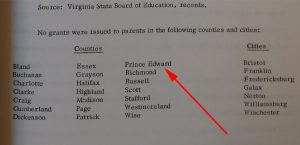As I continue the ongoing dissection of Democracy in Chains, I’d like to turn next to a claim that’s at the heart of its narrative on school desegregation: the notorious closing of Prince Edward County, Virginia’s public school system from 1959 to 1964 as a strategy to avoid racial integration.
Nancy MacLean actually claims that she first discovered James M. Buchanan by accident from a footnote in James Hershman’s work while researching the history of the Prince Edward school closures. We now know that in doing so she appears to have constructed her entire narrative upon a typo in Hershman’s work. But the Prince Edward issue still warrants historical investigation, as MacLean and numerous others have claimed that the closing was a direct result of Virginia’s rudimentary experiment with tuition grants, or school vouchers, between 1959 and 1965. According to this claim, the state’s modest tuition grant program somehow made it feasible to shutter the public schools and transfer all the white students into a private “segregation academy.” The result, of course, infamously shut black students out of the schools entirely.
There’s a problem with this narrative though. For most of the period of the Prince Edward school closure, students in the county were not actually using the state tuition grant program.
Prince Edward set up its whites-only “segregation academy” to open in the fall of 1959 as a response to an integration order, yet for the first year of operation (the 1959-60 term) this school was run tuition-free and relied on private donations by segregationists.
In the 1960-61 term, about 1,300 white students in Prince Edward County did apply for and receive tuition vouchers of between $225-250 a piece through the state program. Their use of the vouchers came to a crashing halt though in late August 1961 before the start of the new school term because of a court injunction barring the program’s operations in the county.
Judge Oren R. Lewis suspended the program on the grounds that Prince Edward County had violated the “freedom of choice” required in the voucher program’s statute. By closing its public schools, Prince Edward actually denied educational choice as specified by law. They were therefore in violation of the statute creating the tuition grant program. As Lewis’s ruling noted:
“An order will therefore be entered restraining and enjoining the County Superintendent of Prince Edward County, the Superintendent of Public Instruction, their agents and employees, and all persons working in concert with them, from receiving, processing or approving any applications for state scholarship grants from persons residing in Prince Edward County so long as the public schools of Prince Edward County remain closed.”
From August 1961 until the reopening of the Prince Edward schools by Supreme Court ruling in 1964, Prince Edward County therefore had no access to the tuition grant program. Combined with the first year being funded through private contributions, the tuition grant program was only operational in Prince Edward County for one school year out of the five year closure period.
State records reflect this reality, as may be seen in a 1964 study by the University of Virginia’s Thomas Jefferson Center (pictured above). Prince Edward County appeared on the list of counties and independent cities that had zero students registered to participate in the tuition grant program.
So there you have it. Even the claim connecting Prince Edward County to the voucher program is based on flimsy evidence. The county’s white residents were only able to utilize the program for one school year before being barred by the court because they ran afoul of the statute’s clear letter.
